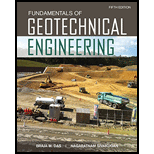
Concept explainers
In concrete work, Fuller and Thompson (1907) suggested that a dense packing of grains can be achieved if the percent finer (p) and grain size (D) are related by the following equation, where n is a constant varying in the range of 0.3-0.6. Dmax is the size of the largest grain within the soil.
This equation is sometimes used in roadwork for selecting the aggregates.
- a. For n = 0.5, show that the soil is well graded.
- b. If n = 0.5 and Dmax = 19.0 mm, find the percentages of gravel, sand, and fines within the soil. Use the Unified Soil Classification System.
(a)
Show that the soil is well graded for constant as 0.5.
Answer to Problem 2.15CTP
The soil is well graded for
Explanation of Solution
Given information:
The range of the constant
The constant value
Calculation:
Show the equation of percent finer as follows.
Here, D is the grain size and
For
Substitute
For
Substitute
For
Substitute
Calculate the uniformity coefficient
Divide Equation (4) by Equation (2).
Calculate the coefficient of gradation
Apply
The value of uniformity coefficient is greater than 6
Hence, the soil is well graded.
(b)
Calculate the percentages of gravels, sands, and fines in the soils based on the Unified Soil Classification System.
Answer to Problem 2.15CTP
The soil contains
Explanation of Solution
Given information:
The range of the constant
The constant value
The size of the largest grain within the soil
Calculation:
For percentage of fines the grain size
For percentage of sand and fines the grain size
Calculate the percentage of fines in the soil.
Substitute
Hence, the percentage of fines is
Calculate the percentage of sand and fines in the soil.
Substitute
Hence, the percentage of sand and fines is
Calculate the percentage of gravel in the soil.
Therefore, the percentage of gravel is
Want to see more full solutions like this?
Chapter 2 Solutions
Fundamentals of Geotechnical Engineering (MindTap Course List)
- a. For an aggregate sample, if you know that the apparent relative density is 2.72 and the water absorption is 1.2%. The dry mass of the aggregate is 514 gm. Find the bulk and saturated surface dry (SSD) relative density values? b. Why does the maximum size of aggregate depend on the clear spacing between bars? Show with a simple sketch. Note: Please answer both a and b... Please answer the both questions.. I don't want single b answer.. thank youarrow_forwardYou are given a result of the gradation test of aggregate, calculate and plot the gradation curve on the given semilog graph sheearrow_forwardIf Poisson's ratio of a material is 0.3, then the ratio of Young's Modulus to bulk modulus is (a) 0.6 (c) 1.2 (b) 0.8 (d) 1.4arrow_forward
- Q2) Layers of Brass, Steel and Aluminum are bonded together and formed section shown below. Cantilever beam is loaded at the tip with 100 kN. In the cross-section height of steel is 50 mm, height of the aluminum is 350 mm and height of the brass is 100 mm. Modulus of clasticity for the materials are given as; Steel, Est = 200 GPa, Aluminum, E = 70 GPa and Brass, Esr= 105 GPa. Find the maximum axial stresses under given loading for Steel, Aluminum and Brass, separately. Steel 150 kN 500 mm 50 mm Aluminum Aluminum 350 mm Brass Brass 100 mm Cross Section of the 5 m Beam Fixed Side view of the Beam Supportarrow_forwardCoarse and fine aggregates defined as the particles that are retained on a 4.75 mm sieve and pass through a 4.75 mm sieve, respectively. Select one: O True on O Falsearrow_forwardCoarse aggregate is placed in a rigid bucket and rodded with a tamping rod to determine its unit weight. The following data are obtained: Volume of bucket = 0.2 cuft Weight of empty bucket is 18.2 lb Weight of bucket filled with dry rodded coarse aggregate = 58.6 lb Calculate the dry-rodded unit weight in lb/ft^3 (one decimal only). Input magnitude only.arrow_forward
- Question 2 The determination of the proportions of various sized aggregates in the aggregate mass is called as ..arrow_forwardIn specific gravity test for coarse aggregate we found the following results: dry weight A= 3008 grams SSD weight B = 3037 grams %3D Submerged weight C=1907 grams The SSD specific gravity Select one: O a. 2.456 O b. 2.877 O c. 2.688 O d. 2.899arrow_forwardThe fineness modulus is a relative measure of how coarse or how fine an aggregate sample is. True Falsearrow_forward
- Given for a set of aggregates: A=2030.9, B 2044.9 and C=1304.3 A = Oven dry weight B = SSD weight. C = Weight in water Find the Bulk Specific Gravity, Bulk SSD Specific Gravity, Apparent Specific Gravity and Absorptionarrow_forwardA 20-mm-wide block is firmly bonded to rigid plates at its top and bottom. When the force P is applied the block deforms into the shape shown by the dashed line. (Figure 1) Part A Determine the magnitude of P. The block's material has a modulus of rigidity of G= 24 GPa .Assume that the material does not yield and use sma angle analysis. Express your answer to three significant figures and include the appropriate units. Figure µA ? Value kN P = 150 mm- You have already submitted this answer. Enter a new answer. No credit lost. Try again. 0.5 mm -- Submit Previous Answers Request Answer 150 mm Provide Feedback Next >arrow_forwardDetermine the ductility of a tested material in terms of percent elongation and percent reduction of area. The test result data is as follows:Do = 0.198 inDf = 0.0888 in Lo = 8 inLf = 9.67 inarrow_forward
 Fundamentals of Geotechnical Engineering (MindTap...Civil EngineeringISBN:9781305635180Author:Braja M. Das, Nagaratnam SivakuganPublisher:Cengage Learning
Fundamentals of Geotechnical Engineering (MindTap...Civil EngineeringISBN:9781305635180Author:Braja M. Das, Nagaratnam SivakuganPublisher:Cengage Learning
